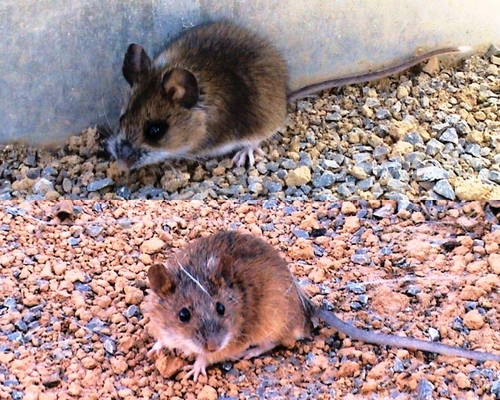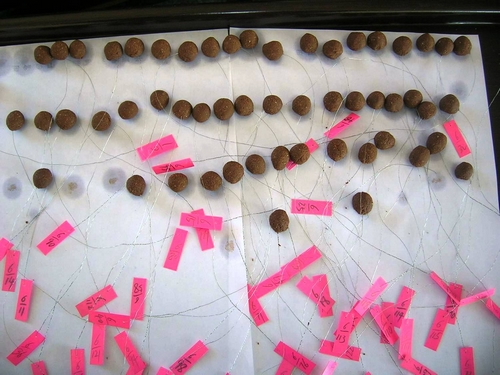传统的观点认为,很多植物种子中含有一定量的单宁等化合物,用于抵御啮齿动物的取食,提高种子的存活机会。中国科学院西双版纳热带植物园动植物关系研究组王博博士和陈进研究员最新的研究表明,埋藏种子的老鼠喜欢取食带涩味的种子,植物种子中一定含量的单宁可能不能减低啮齿动物的取食。研究结果已发表在国际杂志PLoS ONE上。

研究地区主要啮齿动物种类

实验中所用人工种子
具有埋藏种子习性的啮齿动物对多种植物的种子散布、幼苗建成和空间分布格局等有着十分重要的影响,因它们在取食种子的同时对部分种子进行搬运和埋藏,从而起到散布种子的作用;种子性状(如:大小、营养、单宁含量等)会影响啮齿动物的取食偏好。为探讨种子性状如何影响啮齿动物,博士研究生王博及其导师陈进研究员创新性地构建了一种人工种子研究系统,利用该系统可以了解种子性状如何影响啮齿类动物的选择,相关研究成果已于2009年发表在的国际杂志Ecology上。
为了进一步深入探讨种子中单宁含量如何影响啮齿动物的取食和埋藏行为,王博和陈进沿用上述的人工种子研究系统,将不同单宁含量的人工种子分别放置天然林和边长10米的方形人工围栏中,供老鼠选择并跟踪人工种子的去向。结果表明,无论是在天然林还是人工围栏,啮齿动物优先选择中等单宁含量(5%)种子。与此同时,作者用不同单宁含量的饲料在实验室人工饲养老鼠,结果发现5%单宁含量的食物对啮齿动物的存活率和健康状况均无显著负面影响,证明啮齿动物确实能够适应一定单宁含量的食物。
该研究结果暗示,尽管种子中单宁可以总体上降低动物对种子的取食,但对埋藏种子习性的啮齿动物的行为并不能形成精准的控制,植物和啮齿动物在长期的进化中可能已经达到一种平衡和妥协。
该研究得到科技部973项目(2007CB411603)资助。
相关英文论文摘要:
Scatter-Hoarding Rodents Prefer Slightly Astringent Food
The mutualistic interaction between scatter-hoarding rodents and their seed plants is highly complex yet poorly understood. Plants may benefit from the seed dispersal behavior of rodents, as long as seed consumption is minimized. In parallel, rodents may maximize foraging efficiency and cache high-quality resources for future consumption. Defensive compounds, such as tannins, are thought to be a major mechanism for plant control over rodent behavior. However, previous studies, using naturally occurring seeds, have not provided conclusive evidence supporting this hypothesis. Here, we test the importance of tannin concentrations on the scatter-hoarding behavior of rodents by using an artificial seed system. We combined feeding trials and field observations to examine the overall impact of seed tannin concentrations on rodent behavior and health. We found that rodents favored seeds with an intermediate amount of tannin (~5%) in the field. Meanwhile, in rodents that were fed a diet with different tannin content, only diets with high tannin content (25%, 15%, and 10%) caused a significant negative influence on rodent survival and health. Significant differences were not found among treatments with tannin levels of 0–5%. In contrast to many existing studies, our results clearly demonstrate that scatter-hoarding rodents prefer slightly ‘astringent’ food. In the co-evolutionary arms race between plants and animals, our results suggest that while tannins may play a significant role in reducing general predation levels by the faunal community, they have no precise control over the behavior of their mutualistic partner. Instead, the two partners appear to have reached an evolutionary point where both parties receive adequate benefits, with the year-to-year outcome being dependent on a wide range of factors beyond the control of either partner.
英文论文链接:https://www.biodiscover.com/news/bioresearch/library/2341







